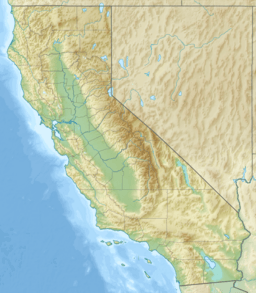Eagle Lake (Lassen County) facts for kids
Quick facts for kids Eagle Lake |
|
|---|---|

The lake and its surroundings from a small peak above
|
|
| Location | Lassen County, California |
| Coordinates | 40°38′42″N 120°44′38″W / 40.64500°N 120.74389°W |
| Catchment area | 600 sq mi (1,600 km2) |
| Basin countries | United States |
| Surface area | 24,000 acres (97.1 km2) |
| Max. depth | 85 ft (26 m) |
| Surface elevation | 5,098 ft (1,554 m) |
Eagle Lake is a special lake in Lassen County. It sits high up at about 5,098 feet (1,554 meters) above sea level. The lake is about 15 miles (24 km) north of Susanville, California.
Eagle Lake is an "endorheic" lake. This means water flows into it, but it does not flow out to the ocean. It is also an "alkaline" lake. This means its water has a higher pH, making it a bit like baking soda dissolved in water. Eagle Lake is the second largest natural lake completely within the state of California, United States.
Contents
Wildlife of Eagle Lake
Eagle Lake is home to many interesting animals. You can find osprey and bald eagles here. The lake gets its name from these majestic birds.
The Amazing Eagle Lake Trout
Eagle Lake is the only place where the native Eagle Lake trout live. These are a special kind of rainbow trout. They can grow very large, sometimes over 10 pounds (4.5 kg)!
These trout have learned to live in the lake's alkaline water. They are the only known trout that can survive in such conditions. Young trout grow quickly, reaching about 17 to 18 inches (43 to 46 cm) in three years. They can live for up to 11 years.
Long ago, there were so many Eagle Lake trout that people fished for them to sell. But then, logging and grazing animals changed Pine Creek. This creek is where the trout go to lay their eggs. It became a stream that sometimes dried up.
In the 1950s, only a few trout were left. People rescued them and started a special program. This program raises trout in a hatchery to keep the species alive. Because of this, the Eagle Lake trout is considered a threatened species. It is one of the most endangered salmon fish in California.
Scientists have also worked to help the trout. From 2007 to 2009, they removed non-native brook trout from Bogard Spring Creek. This creek flows into Pine Creek, and removing other fish helps the native trout.
Other Animals
Most non-native fish cannot live in Eagle Lake. This is because of its high alkalinity. However, in the early 1900s, when the lake level was higher, some Largemouth bass and Brown bullhead lived there for a few years.
American white pelicans used to nest at Eagle Lake. But locals hunted them, thinking they ate the trout. Also, in 1932, water was taken from the lake for farms. This made the lake level drop by 3 meters (10 feet). Their nesting island became a peninsula, and the pelicans stopped nesting there.
How the Lake Works
Eagle Lake was once part of a much bigger lake. This was millions of years ago on the Modoc Plateau. Today, the lake is about 15 miles (24 km) long. It is between 1.8 and 2.5 miles (2.9 and 4.0 km) wide. Its water is very alkaline, with a pH between 8 and 9.
The lake has three main parts, called basins. Two of these basins are about 16 to 20 feet (5 to 6 meters) deep. The third basin is deeper, averaging 32 to 65 feet (10 to 20 meters). It can reach a depth of almost 98 feet (30 meters).
Water Flow and Streams
Several streams flow into Eagle Lake. These include Cleghorn Creek, Papoose Creek, Merrill Creek, and Pine Creek. Pine Creek is the most important stream flowing into the lake. It is about 39 miles (63 km) long. However, only the upper 6.8 miles (11 km) of Pine Creek flow all year round. The rest of it sometimes dries up.
In 1923, a tunnel called the Leon Bly Tunnel was built. It was meant to send water from Eagle Lake to the Honey Lake Valley. This water would go through Willow Creek, which flows into the Susan River. The tunnel is about 2 miles (3.2 km) long.
However, the lake levels dropped, and the tunnel became less useful. A landslide also partly blocked its entrance. Even so, a study in 1990 found that some lake water still flows through the tunnel.
Images for kids
See also
 In Spanish: Lago Eagle (Condado de Lassen) para niños
In Spanish: Lago Eagle (Condado de Lassen) para niños





